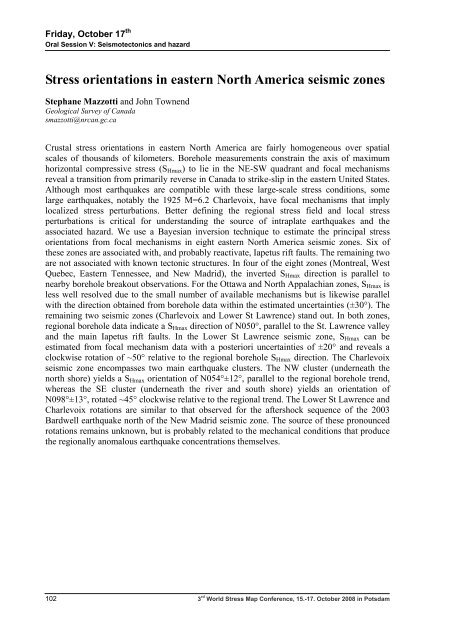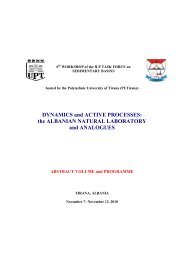World Stress Map Conference - International Lithosphere Program ...
World Stress Map Conference - International Lithosphere Program ...
World Stress Map Conference - International Lithosphere Program ...
You also want an ePaper? Increase the reach of your titles
YUMPU automatically turns print PDFs into web optimized ePapers that Google loves.
Friday, October 17 th<br />
Oral Session V: Seismotectonics and hazard<br />
<strong>Stress</strong> orientations in eastern North America seismic zones<br />
Stephane Mazzotti and John Townend<br />
Geological Survey of Canada<br />
smazzotti@nrcan.gc.ca<br />
Crustal stress orientations in eastern North America are fairly homogeneous over spatial<br />
scales of thousands of kilometers. Borehole measurements constrain the axis of maximum<br />
horizontal compressive stress (SHmax) to lie in the NE-SW quadrant and focal mechanisms<br />
reveal a transition from primarily reverse in Canada to strike-slip in the eastern United States.<br />
Although most earthquakes are compatible with these large-scale stress conditions, some<br />
large earthquakes, notably the 1925 M=6.2 Charlevoix, have focal mechanisms that imply<br />
localized stress perturbations. Better defining the regional stress field and local stress<br />
perturbations is critical for understanding the source of intraplate earthquakes and the<br />
associated hazard. We use a Bayesian inversion technique to estimate the principal stress<br />
orientations from focal mechanisms in eight eastern North America seismic zones. Six of<br />
these zones are associated with, and probably reactivate, Iapetus rift faults. The remaining two<br />
are not associated with known tectonic structures. In four of the eight zones (Montreal, West<br />
Quebec, Eastern Tennessee, and New Madrid), the inverted SHmax direction is parallel to<br />
nearby borehole breakout observations. For the Ottawa and North Appalachian zones, SHmax is<br />
less well resolved due to the small number of available mechanisms but is likewise parallel<br />
with the direction obtained from borehole data within the estimated uncertainties (±30°). The<br />
remaining two seismic zones (Charlevoix and Lower St Lawrence) stand out. In both zones,<br />
regional borehole data indicate a SHmax direction of N050°, parallel to the St. Lawrence valley<br />
and the main Iapetus rift faults. In the Lower St Lawrence seismic zone, SHmax can be<br />
estimated from focal mechanism data with a posteriori uncertainties of ±20° and reveals a<br />
clockwise rotation of ~50° relative to the regional borehole SHmax direction. The Charlevoix<br />
seismic zone encompasses two main earthquake clusters. The NW cluster (underneath the<br />
north shore) yields a SHmax orientation of N054°±12°, parallel to the regional borehole trend,<br />
whereas the SE cluster (underneath the river and south shore) yields an orientation of<br />
N098°±13°, rotated ~45° clockwise relative to the regional trend. The Lower St Lawrence and<br />
Charlevoix rotations are similar to that observed for the aftershock sequence of the 2003<br />
Bardwell earthquake north of the New Madrid seismic zone. The source of these pronounced<br />
rotations remains unknown, but is probably related to the mechanical conditions that produce<br />
the regionally anomalous earthquake concentrations themselves.<br />
102 3 rd <strong>World</strong> <strong>Stress</strong> <strong>Map</strong> <strong>Conference</strong>, 15.-17. October 2008 in Potsdam




